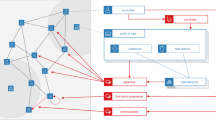Abstract
Existing e-commerce systems employ a pull model of marketing where buyers, possibly through agents, search the e-market for suppliers offering the product of their choice. In contrast, the push model where suppliers’ agents approach buyers with their products, has been relatively less investigated. Push strategies are particularly appropriate for commodities that have a short shelf-life and, therefore, an elastic demand curve, allowing suppliers to exploit unexpected supply. The speed and low cost of e-commerce makes it particularly suited to the push paradigm. In this paper, we consider time-limited goods in a supplier driven marketplace that employs the push model of marketing. When constrained by a strict deadline to sell the good, the supplier uses a mobile sales agent that visits every buyer and estimates the short run demand curve of the good. At every buyer, the sales agent also employs a heuristic technique called the Maximum Returns Algorithm to recalculate the price of the good, so that the supplier can obtain the best possible gross returns from trading with the buyers. On the other hand, when the deadline to sell is not stringent, the sales agent negotiates the exchange at a point that improves both the buyer’s utility and the supplier’s profit, as compared to the exchange point without negotiation.
Similar content being viewed by others
References
Aglets, URL: http://www.trl.ibm.co.jp/aglets.
Amazon Inc., URL: http://www.amazon.com.
AuctionBot, URL: http://auction.eecs.umich.edu.
Bachem, A., W. Hochstattler, and M. Malich. (1992). “Simulated Trading: A New Approach For Solving Routing Problems.” Technical Report 92.125, Mathematics Institute, University of Koln.
Bailey, J. and Y. Bakos. (1997). “An Exploratory Study of the Emerging Role of Electronic Intermediaries,” International Journal of Electronic Commerce 1(3), 7–20.
BargainFinder, URL: http://bf.cstar.ac.com/bf.
Belobaba, P. (1999). “Application of a Probabilistic Decision Model to Airline Seat Invetory Control,” Operations Research 37, 183–197.
Brumelle, S. and M. McGill. (1993). “Airline Seat Allocation with Multiple Nested Fare Classes.” Operations Research 41, 127–137.
Chavez, A. and P. Maes. (1996). “Kasbah: An Agent Marketplace for Buying and Selling Goods.” In Proceedings of the First International Conference on the Practical Application of Intelligent Agents and Multi-Agent Technology. London, UK, pp. 75–90.
Dasgupta, P., N. Narasimhan, L.E. Moser, and P. M. Melliar-Smith. (1999). “MAgNET: Mobile Agents for Networked Electronic Trading.” IEEE Transactions on Knowledge and Data Engineering 11(4), 509–525.
Dasgupta, P. and R. Das. (2000). “Dynamic Pricing with Limited Competitor Information in a Multi-agent Economy.” In Cooperative Information Systems, Lecture Notes in Computer Science 1910. Springer Verlag, pp. 299–310.
Dasgupta, P., L. Moser, and P. M. Melliar-Smith. (2001). “Dynamic Tiered Pricing in a Multi-agent Economy.” In International Conference on Artificial Intelligence. Las Vegas, NV, pp. 1142–1148.
Dealtime, URL: http://www.dealtime.com.
Dolan, R. and H. Simon. (1996). Power Pricing. Free Press, New York, NY.
Doorenbos, R., O. Etzioni, and D. Weld. (1997). “A Scalable Comparison/Shopping Agent for the World Wide Web.” In Proceedings of the First International Conference on Autonomous Agents. Marina del Rey, CA, pp. 39–48.
E-Bay Inc., URL: http://www.ebay.com.
E-Mediator, URL: http://ecommerce.cs.wustl.edu/eMediator.
Guttman, R. and P. Maes. (1998). “Cooperative vs. Competitive Multi-Agent Negotiations in Retail Electronic Commerce.” In Proceedings of the Second International Workshop on Cooperative Information Agents. Paris, France pp. 135–147.
Guttman, R., A. Moukas, and P. Maes. (1998). “Agent-Mediated Electronic Commerce: A Survey.” Knowledge Engineering Review 13(2), 147–159.
Jango, URL: http://www.jango.com.
Kephart, J., J.E. Hanson, and A.R. Greenwald. (2000). “Dynamic Pricing by Software Agents.” Computer Networks 32(6), Elsevier, 731–752.
Lange, D.B. and M. Oshima. (1998). Programming and Developing Java Mobile Agents with Aglets, Addison-Wesley, Menlo Park, CA.
Lange, D., M. Oshima, G. Karjoth, and K. Kosaka. (1997). “Aglets: Programming Mobile Agents in Java.” In Proceedings of the International Conference on Worldwide Computing and Its Applications. Tsukuba, Japan. Lecture Notes in Computer Science 1274, Springer-Verlag, Berlin, Germany, pp. 253–266.
Maoi, URL: http://www.maoi.com.
Miller, G., J. M. Rosenblatt, and L. J. Hushak. (1988). “The Effects of Supply Shifts on Producer’s Surplus.” American Journal of Agricultural Economics 70(4), 886–891.
My Simon, URL: http://www.mysimon.com.
Nicholson, W. (1989). Microeconomic Theory, Fourth Edition. The Dry den Press, Orlando, FL.
Papaioannou, T. (2000). “On the Structuring of Distributed Systems: The Argument for Mobility.” Ph.D Thesis, University of Loughborough, UK.
Price Line, URL: http://www.priceline.com.
Shardanand, U. and P. Maes. (1995). “Social Information Filtering: Algorithms for Automating ‘Word of Mouth’. In Proceedings of the Computer-Human Interaction Conference. Denver, CO, pp. 210–217.
Smith, R. (1980). “The Contract Net Protocol: High-Level Communication and Control and a Distributed Problem Solver.” IEEE Transactions on Computers 29(12), 1104–1113.
Site Sell Inc., URL: http://www.sitesell.com.
Talus Solutions, URL: http://www.talussolutions.com.
Tsvetovatyy, M., B. Mobasher, M. Gini, and Z. Wieckowski. (1997). “MAGMA: An Agent-Based Virtual Market for Electronic Commerce.” Applied Artificial Intelligence 11(6), 501–523.
Wurman, P., M. P. Wellman, and W. E. Walsh. (1998). “The Michigan Internet AuctionBot: A Configurable Auction Server for Human and Software Agents.” In Proceedings of the Second International Conference on Autonomous Agents. Minneapolis, MN, pp. 301–308.
Yahoo Store, URL: http://store.yahoo.com.
Author information
Authors and Affiliations
Corresponding author
Additional information
This research has been supported by QAD Inc. through the California Micro Program, Grants 97-122 and 98-107 and by the DARPA/ONR Grant N66001-00-1-8931.
Rights and permissions
About this article
Cite this article
Dasgupta, P., Moser, L.E. & Melliar-Smith, P.M. Dynamic Pricing for Time-Limited Goods in a Supplier-Driven Electronic Marketplace. Electron Commerce Res 5, 267–292 (2005). https://doi.org/10.1007/s10660-005-6159-y
Issue Date:
DOI: https://doi.org/10.1007/s10660-005-6159-y




